Navigating the Legislative Landscape of Workplace Harassment and Discrimination in 2024
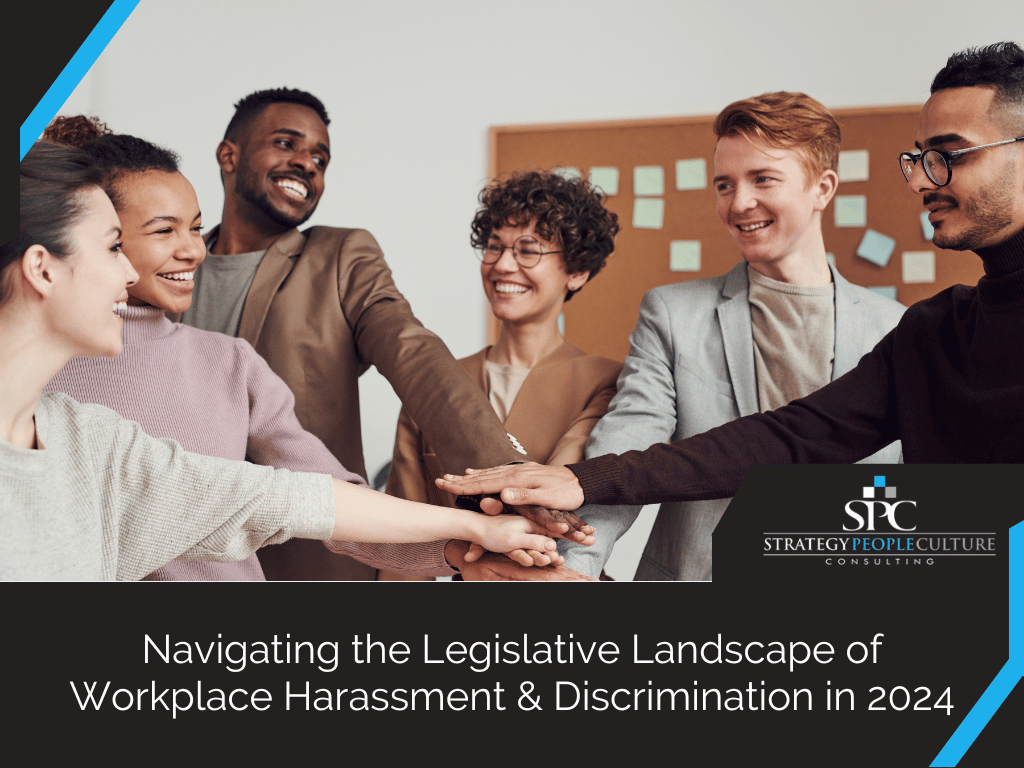
In 2023, the legislative landscape governing workplace harassment and discrimination has evolved significantly, reflecting a more stringent approach toward further creating safer and discriminatory-free work environments. This evolution is not merely a response to the growing awareness and intolerance of such behaviors but is also indicative of legislative bodies’ efforts to enforce accountability and establish guidelines around equity.
In 2024, the future outlook necessitates a proactive stance, urging leaders to go beyond mere legal adherence and envision workplaces where diversity is celebrated and fairness is ingrained.
Understanding these changes is paramount for business leaders, not only to ensure compliance but also to meet the direction the workforce is demanding by fostering a culture of respect and dignity. Let’s delve into some recent developments and identify valuable insights for navigating workplace harassment and discrimination laws.
The Present State of Workplace Harassment and Discrimination in the U.S.
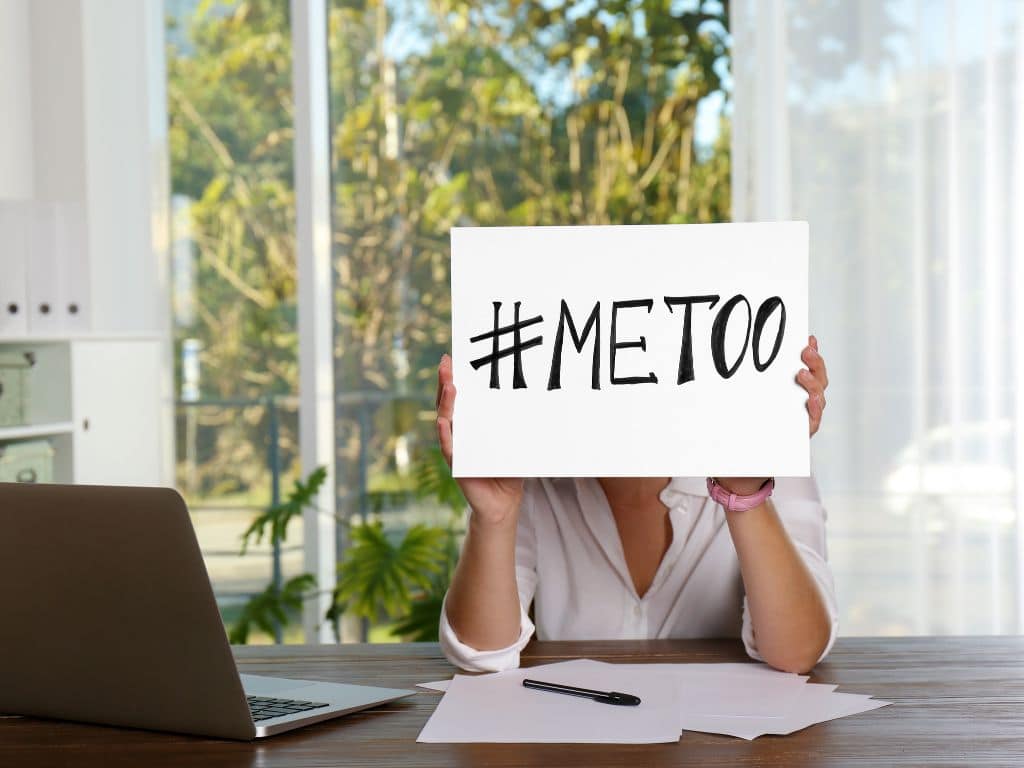
Amid the global calls for equity and respect and the five years after the #MeToo Movement, the workplace has become a central battleground for these ideals. Instances of harassment and discrimination have been cast into an unforgiving spotlight, prompting organizations and legislators to reevaluate the status quo.
Workplace harassment and discrimination have evolved in several ways:
- They now often appear subtly through microaggressions and implicit biases, making them harder to identify and tackle.
- The shift to remote work and digital interactions has opened up fresh avenues for mistreatment, like cyberbullying and online harassment, fostering toxic work environments beyond traditional offices.
These changes highlight the importance of robust policies and proactive steps to address all types of harassment and discrimination, whether in physical or virtual work environments.
U.S. legislation is addressing these concerns through a range of measures, including:
- The Forced Arbitration of Sexual Assault and Sexual Harassment Act of 2021, which fostered greater fairness and transparency in dealing with sexual harassment and assault cases, and…
- The EEOC’s Proposed Harassment Guidance Addressing Remote Work and LGBTQ+ Harassment, which clarifies the legal standards and employer liability for harassment claims under federal law.
Additionally, more states are enacting laws to extend the statute of limitations for filing claims.
In the modern workplace, the #MeToo movement catalyzed a series of revamps to harassment and discrimination statutes. Businesses must understand and align with these legal frameworks to cultivate a truly inclusive and compliant culture.
The Speak Out Act: Giving Voice to Victims, Restoring Balance of Power
On Friday, February 23, 2024, the Utah state legislature enacted a bill rendering confidentiality clauses in cases of sexual assault and harassment unenforceable.
The “Speak Out Act“ is a milestone, ensuring no voice goes unheard and no pain unaddressed, especially in the state of Utah, where numerous women have recounted facing a culture of sexism and harassment within their workplaces. Across the country, the prevalence of confidentiality clauses, typically manifested as nondisclosure and non-disparagement agreements, tends to silence employees, preventing them from reporting instances of sexual harassment or assault within their companies.
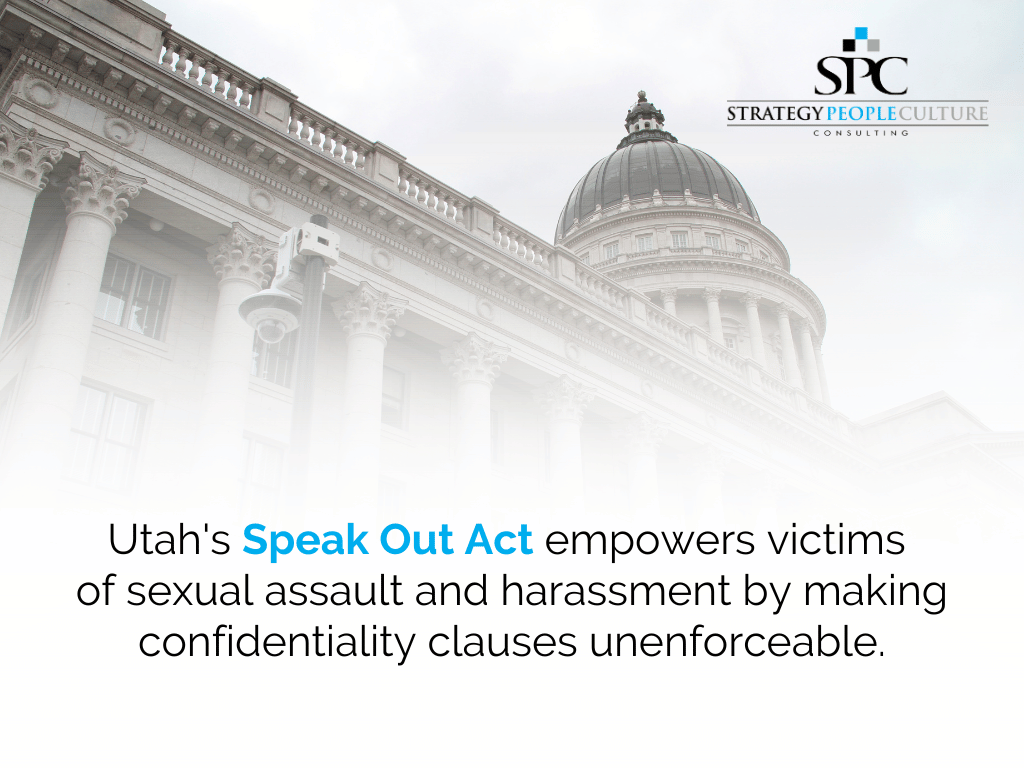
The Implications of NDAs in the Workplace
Non-disclosure agreements (NDAs) in the context of sexual harassment cases within the workplace have long been a contentious issue, bearing significant controversy and legal challenge. Organizations use these instruments primarily to protect their reputations and sharing of information they would prefer to remain proprietary. Employees may look at these as a way organizations intimidate them to remain silent, thus perpetuating a culture of secrecy that allows predatory behaviors to continue unchecked and unaddressed. The legislative trend has been to reduce the enforceability of NDAs with the perspective that NDAs hinder the potential for systemic change, as they prevent the sharing of information that could lead to broader awareness and institutional reform.
A Step Towards Victim Empowerment
By focusing on workers’ rights to speak and be heard, the Act reshapes power dynamics in the workplace. The Speak Out Act’s ripple effect is palpable as a growing number of corporations renounce NDAs in instances of discrimination and harassment.
As the Act’s impact unfolds, Utah is setting an example for other states looking to tackle workplace discrimination and harassment head-on. However, it remains to be seen how this law will be enforced and if it will truly shift the power balance in the workplace.
California’s Approach to Combating Harassment: Training Towards Equality
California’s robust stance on workplace equality is manifested through its progressive approach to anti-harassment training. California’s emphasis on prevention is a strategically forward-thinking methodology that other regions are closely watching and considering emulating.
Senate Bill 1343: A New Standard for Harassment Training

An in-depth examination of California’s mandatory harassment training initiative reveals a comprehensive vision for fostering an inclusive workplace. From the specifics of the required curriculum to the timeline for compliance, this section will clarify the state’s expectations of employers.
Key amendments to the mandatory training requirements under Senate Bill 1343 are:
- The new law applies to employers with five or more employees, compared to the prior law, AB 1825, which only applies to employers with fifty or more employees.
- Training is now required for both supervisory and non-supervisory staff, extending the mandate much further than the old law, which only required supervisors to receive training.
- Supervisors are required to receive two hours of training, while non-supervisory staff must only receive one hour of training.
- Training content must now encompass harassment based on gender identity, gender expression, and sexual orientation, as well as contain practical examples of such harassment.
- The law applies to all public agencies, most non-profit employers, and private employers, regardless of size.
- The law mandates that migrant and seasonal agricultural workers need to be trained, with temporary workers to be trained by their respective agencies.
- Under the new mandates, new hires must be trained within six months of employment, with non-supervisory staff who are not new hires requiring training by January 1, 2021.
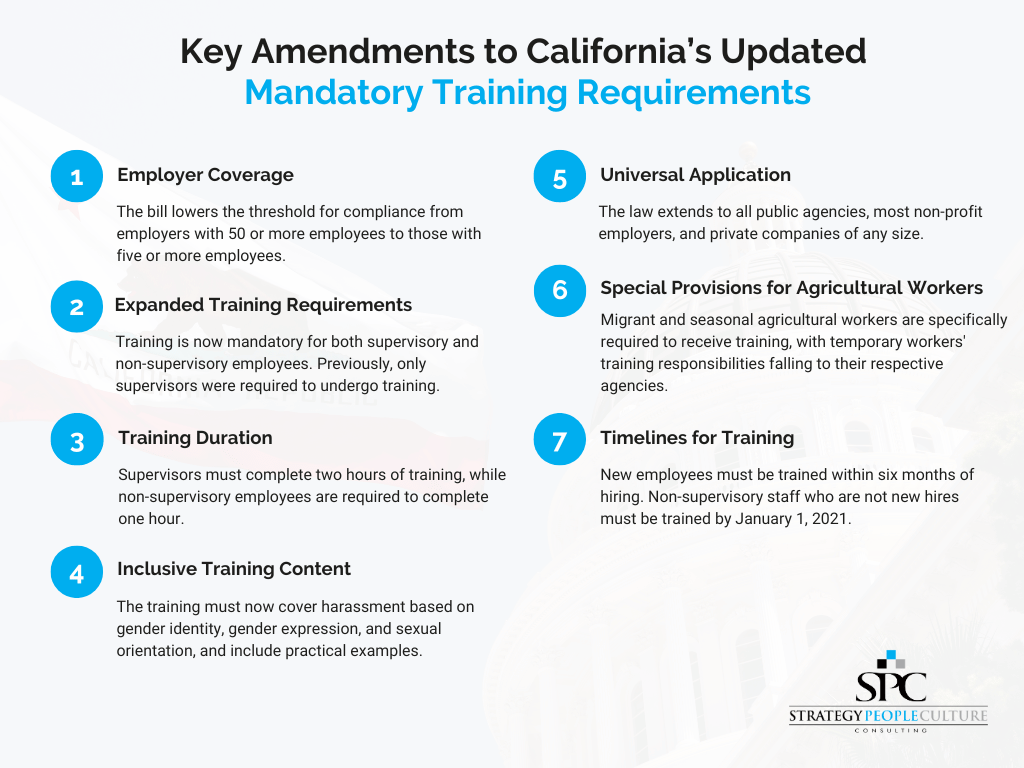
The Consequences of Non-Compliance
California’s trajectory in enforcing its rigorous training guidelines demands attention. Financial penalties are not the sole jeopardy for non-compliance—reputational damage and the loss of key talent are equally dire consequences.
Promoting a Safe, Respectful, and Inclusive Work Environment
While the law mandates specific actions, it is the spirit of the initiatives that truly captivates. This segment will focus on the cultural transformation that California hopes to inspire by going beyond compliance to foster authentic, sustainable change.
New York’s Updated Sexual Harassment Model Policy
Striving to foster a safe and professional workplace, New York has positioned itself as a leader in developing policies that align with the needs of today’s workforce. The state’s attentiveness to detail and dedication to adapting to changing tides is palpable in its updated sexual harassment model policy.

The updates to New York’s sexual harassment model policy represent a significant leap forward in protecting employees and ensuring a harassment-free workplace. Key amendments include:
- Mandatory Training Enhancements: The updated policy emphasizes not just the frequency but also the quality of sexual harassment training. Training programs are now required to be interactive, culturally competent, and tailored to the specific industry and the employer’s workplace. This aims to foster a deeper understanding and awareness amongst employees and managers alike.
- Expanded Definition of Sexual Harassment: The Model Policy now includes cisgender, transgender, and non-binary persons in the definition of sexual harassment. It emphasizes that all forms of gender discrimination are considered sexual harassment. This is intended to provide stronger protections against sexual harassment for all employees, regardless of their gender identity.
- Remote Work Considerations: The Model Policy clarifies that sexual harassment can occur even when employees are working remotely, including having inappropriate materials visible during virtual meetings. This ensures that the policy keeps up with the changing dynamics of work amidst the increasing prevalence of remote work.
- Clarified Retaliation Section: The updated policy offers expanded examples of retaliation, such as demotion, termination, or reduced hours. This aims to give employees a clearer understanding of what constitutes retaliation and how to recognize it.
- Proactive Role of Managers and Supervisors: The policy now requires managers and supervisors to intervene proactively if they observe sexually harassing or discriminatory behavior instead of waiting for an employee to file a complaint. This is designed to encourage a more active role from leadership in preventing harassment and discrimination.
- Bystander Intervention: The updated policy introduces a section on bystander intervention, providing standard methods that anyone can use when they witness harassment. This is intended to empower employees to act and support each other in such situations.
- Applicability to All Protected Classes: While the focus of the Model Policy is on sexual harassment and gender discrimination, it states that the prevention policies should be applicable to all protected classes. This is to ensure that all employees, regardless of their personal characteristics or identities, are protected against discrimination and harassment.
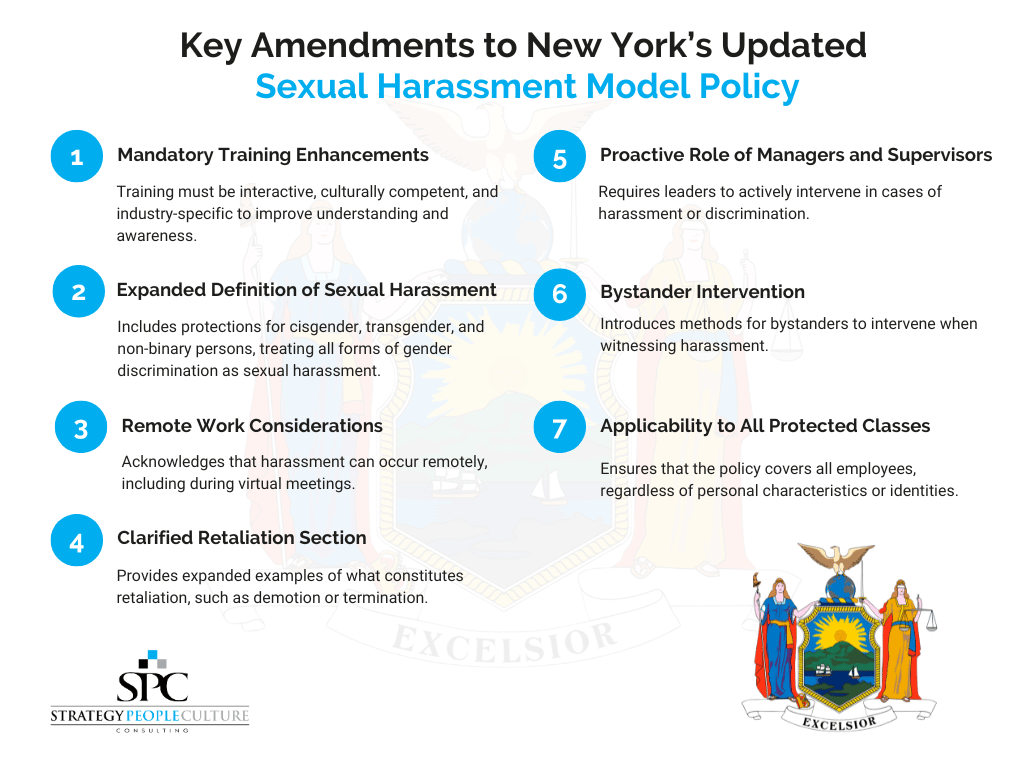
The intended impact of these updates is to create a more informed, vigilant, and supportive workplace environment. By broadening the understanding of what constitutes sexual harassment, enhancing the mechanisms for reporting and addressing incidents, and providing support for victims, New York aims to not only mitigate the occurrence of harassment but also empower victims and bystanders to take a stand against it.
Conclusion
It is evident that 2024 is a pivotal year in the evolution of workplace equity and safety. The intersection of law and culture is producing a multifaceted quilt of reforms that aim to protect the sanctity of the work environment while still nurturing growth and prosperity. The challenges ahead are weighty, requiring collective action and careful attention by employers around the United States. By staying informed, engaged, and proactive, employers can ensure they are managing their risk, mitigating issues of harassment and discrimination in their organizations, and facilitating inclusive cultures, ultimately leading to a more productive and healthy work environment.
When faced with the challenges of today’s workplace, ensuring your organization has the right safeguards in place is critical. These safeguards can include effective training, neutral workplace investigations, and leadership development through management training and executive coaching. At Strategy People Culture, this is our expertise. Schedule a consultation with us today to start your journey.
